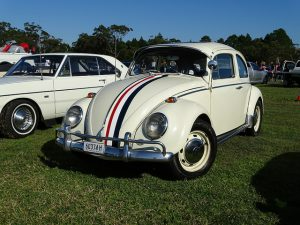
You may not realize the long history of the VW “bug”. This vehicle dates back to 1938, and it has gone through some significant milestones and changes since then.
The Beetle of the 1930s
The first model of the VW “bug” came out in 1938. Unfortunately, before the car could gain mainstream popularity, Volkswagen factories were pulled into the war efforts. The public did not get their hands on the first Volkswagen bug until 1947. During the early phase, the car was mainly used by the military and by elites in Germany; Hitler’s specifications were actually some of the requirements that shaped the early designs of the Beetle.
Beetle Production Resumes
After the war, Volkswagen production resumed, and the company set its sights on selling the car in America and other countries, such as the U.K. Although the bug was available in the US in the 1940s, it didn’t become extremely popular until later. Heinz Nordhoff was instrumental in making it feasible for the Beetle to be sold overseas. He made major improvements to the production assembly line that made it easier to construct high-quality vehicles quickly and accurately.
The Beetle Becomes Mainstream in America
It wasn’t until the 1960s that the Beetle started to gain popularity in America. It became a symbol of hippie culture. The advertising company Doyle Dane Bernbach played an important role in selling the VW car to Americans. Its clever advertising highlighted the simplicity and high-quality craftsmanship present in the vehicle.
As the Beetle became more popular, a few different options emerged. The convertible VW had its heyday in the 1960s. The Super Beetle was a variant of the model that was larger and came in various styles. The Champagne Bug, Fun Bug, and Sun Bug were just a few of the different personality Beetles to show up on the market. Drivers began to see the Volkswagen Beetle as a way of expressing their unique personality.
VW Beetle Wanes in Popularity as the Golf Takes Off
In 1974, Volkswagen introduced a new car that would capture people’s attention: the VW Golf. The car would be seen as being more practical, functional, and mainstream than the Beetle. As these traits started to supersede quirkiness as desirable traits in late 1970s and 1980s, the Beetle’s popularity started to fall. Production in some countries slowly came to a halt. For example, the Mexico production line completed its last Beetle in 2003.
The Beetle Becomes a Niche Car
That’s not to say that there aren’t die-hard Beetle lovers out there today. Volkswagen has since upgraded the Beetle with more features, such as a more powerful engine, options for all-wheel drive, and GTI-like handling. Those who love the design of the Beetle can now count on a vehicle that keeps up with the demands of the modern road.
The VW Beetle is not just a history lesson. Current models of the Beetle keep the design evolution intact, adding newer technologies on top of a classic design. VW of Akron carries the most current iteration of the VW Beetle, which you should certainly see for yourself.